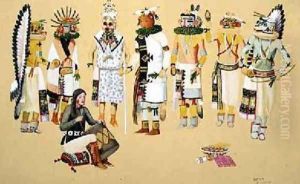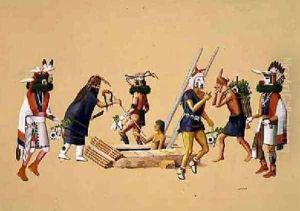Waldo Mootzka Paintings
Waldo Mootzka was a Native American artist born in 1915 in the village of Hotevilla on the Hopi Reservation in Arizona. His Hopi name was Kutcahanauu, meaning 'Yellow Woodpecker Girl,' despite him being male. The name was indicative of his clan, which is a tradition among the Hopi. Mootzka grew up in a cultural environment that was rich with artistic expression, including pottery, weaving, and kachina doll carving, which are traditional Hopi crafts.
Mootzka began painting at an early age and was one of the students of the Santa Fe Indian School, where he was taught by Dorothy Dunn in the 1930s. Dunn was an influential teacher who encouraged her students to paint in a flat, two-dimensional style that became known as the Studio style, emphasizing traditional Native American themes and imagery. Mootzka was one of her most talented students and his work often featured scenes from Hopi legends and daily life, executed with a strong sense of design and color.
Tragically, Waldo Mootzka's life was cut short when he died at the young age of 27 in 1942. Despite his brief career, he left behind an impressive body of work that has been celebrated for its contribution to the development of Native American art in the 20th century. His paintings are characterized by their vibrant colors and intricate patterns, showcasing traditional Hopi culture with a modern aesthetic. Mootzka's work has been exhibited in various galleries and museums, and he continues to be remembered as a significant figure in the history of American Indian art.

